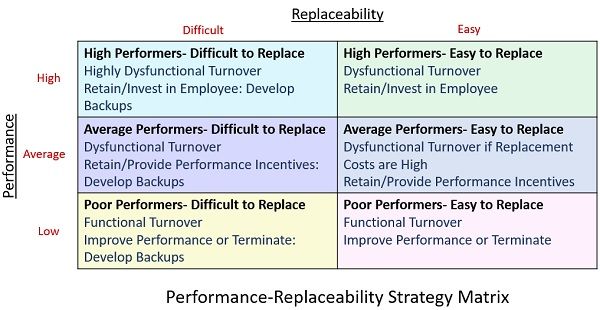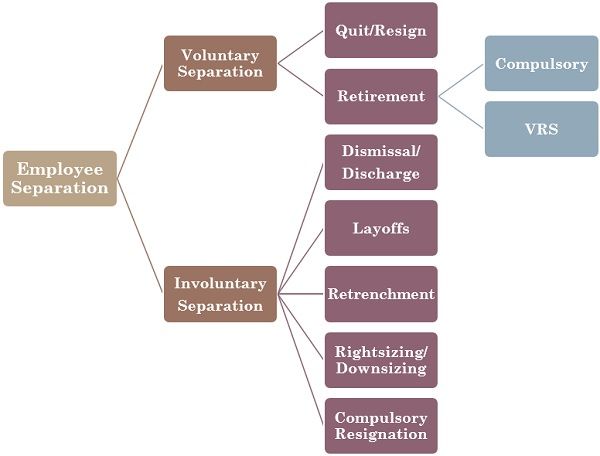Definition: Employee Separation is the discontinuation of his employment contract with the company. The termination of employees services can be either Voluntary or Involuntary. This can take the form of Retirement, Resignation, Discharge, Layoff, etc.
The companies and employees must specify valid reasons behind their separation. The process may be upsetting for both, company and its employees.
Hence, the employee separations should be well planned and reasonable. One must have a good experience post separation. As employees feedback builds the company’s image among prospecting candidates.

The employer should provide the required guidance to employees. The firms may conduct discussions and counselling sessions during separation.
Exit Interviews of the separated employees are conducted. It helps to gather in-depth information about companies strengths and weaknesses.
Content: Employee Separation
Types of Employee Separation
Either employer or employee may propose separation due to several reasons. The employee separation can be classified into:
- Voluntary Separations
- Involuntary Separations
Voluntary Separations
Here, the employee discontinues his services on his own consent in the organization. The most common forms of voluntary separation are:
- Resign or Quit
- Retirement
Resign or Quit
The employee may quit his job due to personal or professional reasons. It may affect the goodwill of the company when it occurs often. The employee may leave because of reasons like:
- Better Career Opportunities
- Company Policy
- Health
- Relocation
- Job Dissatisfaction, etc.
Retirements
Retirement is the completion of employees occupational tenure. This involves discontinuation of service as the employee reaches the age of retirement.
However, the employees themselves take retirement from the organization through Voluntary Retirement. Generally, the age of retirement is 60 years. Unlike resignation in retirement, employees gain certain benefits like:-
- Lump-Sum Payment
- Pension
- Leave Encashment
- Gratuity, etc
Retirement can be of two types:
Compulsory Retirement
When employees reach the age of superannuation, they have to retire compulsorily. The retirement age varies in different sectors.
In the government sector, the retirement age is 58 or 60 years. Whereas there is no fixed age of retirement in the private sector. It depends on the person capabilities of working.
Voluntary Retirement Scheme(VRS)
The employees can opt for retirement before reaching retirement age. It is also known as the Golden Handshake Scheme. The organization offers VRS to its employees.
Through VRS, companies can cut costs, get a manageable workforce and handle business losses.
Involuntary Separations
Here, the employer terminates the services of their employees due to organizational reasons. The organizations may opt for employee separation because:
- They may face ups and downs in the business cycle
- Difficulty in handling the workforce
- Unprofessional behaviour of the employees
The different types of involuntary separation are:
- Discharges and Dismiss
- Layoffs
- Retrenchment
- Downsizing and Rightsizing
- Compulsory Resignation
Discharges and Dismiss
Discharge is an involuntary separation in which the organization ceases employee services. The discharge of the employee might be due to his non-productivity. While discharging, an employee may get offended. Thus, it must be a thoughtful decision and adopted in only extreme cases.
It may be a product of:
- Job Misfit
- Bad Organizational Behaviour
- Absenteeism
Dismissal is the termination of the employee resulting from his non-performance or misconduct. It is the last step the management take as a punishment to the employee. It may impose adverse effects on employees career opportunities in future.
Layoffs
A Layoff is when an organization separates their employees for a short stretch of time. The organization recalls the employees after the layoff period is over. The objective of laying off the workforce is to make the firm lean in shape and remain competitive.
The organization carry out layoff of employees based on their excellence or seniority. The reasons behind layoffs can be:
- Merger
- Acquisition
- Competitive Environment
- Changes in Technology
- Downsizing, etc
The management must specify and communicate the reasons and basis of layoff. It has a negative impact on the victims, survivors and managers involved in the layoff process.
Points to Remember
- The employee must receive compensation during the tenure of layoff. It can be half the remuneration paid to the employee.
- Organizations might follow the Last-In-First-Out approach.
- The employer should convey the period of layoff if possible.
- Management should recall productive employees first.
Retrenchment
In this, organizations need to separate employees permanently due to economic reasons. The organizations may not recall employees. But they can prefer retrenched workers at the time of vacancies.
The following can be the economic reasons behind retrenchment:-
- Surplus Staff
- Machinery Installation
- Rationalization
- Department Closure
- Decreasing Demand for Products
- Economic Slowdown
The firm has to seek approval from the government. Along with that, it provides a notice to the employees beforehand.
Downsizing and Rightsizing
The organizations restructure themselves by downsizing and rightsizing their workforce. Rightsizing includes cost-saving and adjusting the crew to exact fit. The organization may cut costs by part-time work, reduced wages, reduced workweeks, etc.
Downsizing refers to making the organization lean by reducing the force. Layoffs are mandatory in Downsizing, whereas Rightsizing may adjust the existing workforce.
Compulsory Resignation
The employer may ask its employee to leave the organization or resign. The organizations opt for obligatory resignation in critical situations and avoid dismissal.
Compulsory Resignation is a better option than Dismissal or Discharge. The organization’s goodwill remains unaffected. Moreover it does not affect the employee’s career too.
Benefits of Employee Separation
Separation is not necessarily a negative process. Besides it may benefit organization and employees in following ways:
To Organizations
- It enables a reduction in labour costs
- Replacement of the poor performers
- It increases opportunities for diversification and enhancement
- New recruits bring synergy within the organization
- Results in a disciplined work environment
- Reshape organization into the right size
To Employees
- Better career opportunities
- Get away from a troublesome workplace
- Enjoy benefits associated with retirement schemes
Employee Separation Process

- Notification: Both the company and the employee may send a notification to the HR department. The notification addresses the request or decisions about separation.
It specifies the following details:- Identity of the employee
- A valid reason for separation
- The final day of work
- Termination Checklist: The manager must collect data, documents, and properties from the employee. He must complete and submit the termination checklist.
The manager handovers the collected stuff to the respective departments. This process takes place on the employee’s final working day. - Final Payment: Employee submits no dues to the finance department, after completing the necessary documentation.
Thereafter, the finance department will disburse the final payment to the employee.
Cost and Separation
There are certain costs associated with employee separation. The separation involves the elimination or replacement of the employee. It includes both ‘cost-cutting’ as well as ‘cost-addition’, depending on the two factors:-
- Elimination of employee position
- Replacement of employee
Eliminating the employee’s position reduces cost in the long run. The firms can save the cost involved in paying compensation and add-on benefits.
Replacement of employees results in the cost addition. The replacement involves employee separation and recruitment. It involves the appointment of another employee for the same position. The recruitment process involves several costs like:
- Recruitment Cost
- Selection Cost
- Training and Development Cost
- Compensation Pay and Benefits
Managing Separation
Separation takes place in every organization, either voluntary or involuntary. It possesses certain benefits and carries some costs. The organizations must aim to reduce costs and amplify the associated benefits.
Any separation relies upon employees performance and replaceability. The preparation of the Performance-Replaceability Strategy Matrix depends on the above elements.

This model places employees in six cells depending on their performance and replaceability.
These cells show problematic or fruitful turnover. Also, they display suitable strategies for managing each turnover. The strategies may include Retention or Termination.
Organizations usually retain high performing employees. Formulation of retention strategies for such employees are:
- More career development opportunities
- Customized incentives based on performance
- Backup for the employees who are hard to replace
Final Words
Employee separation is the discontinuation of employees services from his workplace. The reasons are personal or organizational factors.
Employee separation has several benefits. But, it has adverse effects on the mental health of the departing and existing employees. Firms should manage separations strategically and try to minimize their impact.

Dr. Atluri Bala Saraswathi says
Nice article which is precise…
Isaac Sopia says
Great work!
Piyush Rao says
Good informative artical…. 🙂
Richard Kayumbo says
Very helpful article.